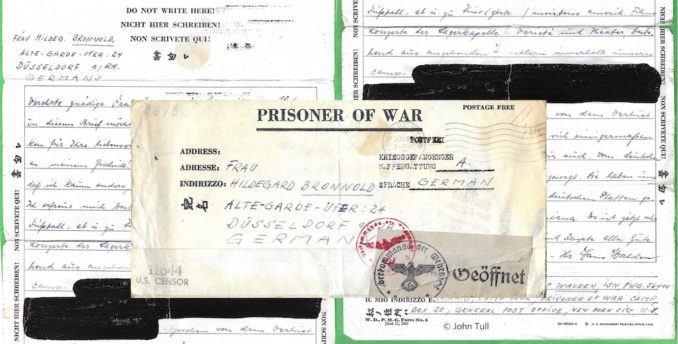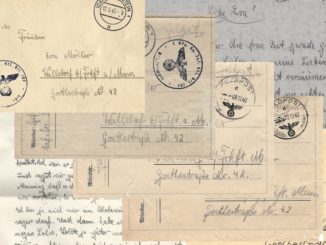In Part 5, I described how Afrika Korps Obergefrieter, Hans Walden, had written to Hildegard Bronnold about being strafed by the American Airforce, visiting the theatre in Tunis and staying at the home of an Arab.
The Stab Nachschub-Kolonne-Abteilung 572 (572nd Motorized Supply Column Battalion) that he belonged to was identified as having been being “destroyed” in May 1942 so what had happened to Hans Walden?
Two further pieces of correspondence were with the letters I have that belonged to Hildegard Bronnold.
The first, on an official letter form and with censor’s redactions, was sent on the 12th of July 1944 from America shows that Hans Walden had been captured by the Americans in Tunisia and was now a prisoner of war held at Camp Polk in Louisiana.

© John Tull 2025, Going Postal
According to Rickey Robertson of the Stephen F. Austin State University:
“…in 1943 German POWs began to arrive in Leesville, La. by rail. The POWs would embark at the rail depot and would march several miles to their new home at Camp Polk. These German POWs were veterans of the Afrika Korps and had been captured in North Africa. After being processed in North Africa, they were placed on ships and were transported to ports in the United States. Many POWs were in tattered uniforms, many in blood stained uniforms, and many were confused at their new surroundings…”.
These Afrika Korps veterans were soon settled in as, “These POWs were a long way from Germany, but they were still soldiers. In every camp the POWs still underwent military rituals such as lights out, reveille, formations, marching, and other soldierly details. Authority was established by rank. Each POW Camp had a ranking German officer in charge of the POWs. The German POWs proved to be very good workers in Louisiana. Many were from farms and were good farm hands who knew how to milk cows, plant crops, harvest crops, and do odd jobs. They were eager to get out from behind the barbed wire. In Leesville, POWs helped to paint many of the downtown buildings, with one German artist painting beautiful pictures of German topics. These still survive and are part of Leesville history…”.
“In the Peason and Peason Ridge area, since 1941 the US Army had held large scale manoeuvres and literally hundreds and hundreds of entrenchments had been dug everywhere. Here in Peason, Mr. Woodrow Herrington’s plow horse had gotten out of the field and was found dead with a broken neck in a deep entrenchment. A plow horse was a very important thing on a farm and now Mr. Woodrow would have to make do till he could find another horse. It was decided to put the German POWs to good use in our area. The US Army brought a large convoy of German POWs from Camp Polk in the summer and fall of 1944 to Peason and set up a bivouac site for them. These POWs were issued shovels, picks, hoes, cant hooks, and other tools and were advised to find and cover up all the open entrenchments.
There were supposedly several hundred Germans who fanned out throughout the area and began to cover up these foxholes, trenches, mortar and artillery pits, and bunkers. After a day or so, a local farmer happened to see a group of men in German Army uniforms going through the woods at Peason. Very shortly the news was out to every farm that the Germans had landed and were in Peason. Every farmer grabbed a shotgun and headed out to do battle with the German Army. It didn’t take long to see the Germans were not armed and the American guards quickly advised everyone that these were prisoners of war from Camp Polk. After settling this problem so the farmers knew who they were, the Germans worked for nearly 3 weeks. They were even given water and food by friendly farmers to help with their army field rations. None of the POWs made any type of attempt to escape on this detail and from what I can find out, none escaped from Camp Polk during the War.”
In the first POW camp letter I have, Hans is replying to a letter from Hildegard, “In this letter I would like to thank you once again for your kind lines and your sympathy for my fate! You can see from the format of the letter, that I can hardly do anything other than telegram-style writing. I am in the best of health. Lots of sport. Football from time to time. Cinema mostly American films. Concerts of the camp band variety and theatre consisting of budding whispers within our camps. [Several lines redacted]. The German Red Cross takes very good care of us.”
The German Red Cross were active in contacting POWs and connecting them with relatives and friends back in Germany, in sending POWs parcels and had sent the POWs in Polk supplies of German records. “Our camp is in Louisiana. It is very warm here now. All the best to your husband and Renate and my warmest greetings”.

© John Tull 2025, Going Postal
The second letter I have, written on the back of a small official postcard, was written on the 27th of July 1944 and it appears that Hans was concerned that he had no communication from Hildegard, “Here is a short greeting card, I am doing good. My hope, that you are also not like this. I would like to see confirmed by Post from you. I hope so at least; and I will be exceedingly happy, when there is another sign of life from you.”
So what happened to Hans after Camp Polk?
According to Rickey Robertson “Throughout their stay at Camp Polk the Germans made many friends with local Americans that have lasted over the many years. By 1946 the POWs were all on their way back to their homes in Germany. Nothing is left of the old camp to make anyone think that during World War II there were German POWs housed there.”
From personal research, I have found that this was not the case as the Afrika Korps POWs still had another ordeal to get through before they got back to their homes.
The Americans put the Afrika Korps POWs on troopships going to France that were to then bring back returning GIs. On arrival in France, the French promptly detained them and marched them off to forced labour camps where they were used as workers in zinc and coal mines as well as in clearance and building reconstruction. This happened because the 1929 Geneva Convention intended the release of prisoners should form part of the armistice and that repatriation of prisoners should be then effected with the least possible delay after the conclusion of peace. There was however no armistice agreed with Germany, due to their unconditional surrender, with a full peace treaty not actually signed until 1990.
From various sources, I have found indications that some Afrika Korps POWs did not get back to Germany until the late 1940s or potentially early 1950s from France. Was Hans Walden amongst them? Unfortunately, I cannot find any trace of him in online records in Germany or on the family history sites Ancestry or Find My Past. So his fate is a Desert Mystery.
What about Hildegard Bronnold? As Hildegard Berta Martha Kuring, she had been born on 24 December 1902 at a military base in Wesel, Rheinland, the daughter of Herman Paul Kuring and Pauline Emma Olga Hulda Wagner.
As well as the letters from Hans Walden, I have FeldPost letters from two of her cousins (“vettern”). Her cousin Unteroffizier Erich Kuring, a driver of a “Kdr-Wagen” (a four-wheel drive Volkswagen Beetle used as a staff car) in the “1.-4. Kompanie Grenadier-Regiment 82” wrote to her on the 6th of August 1943 from “Russland”. He was reported missing the same month in the Donezbecken (the Donbas basin in Ukraine) and appears to have no known grave.
Another cousin, Oberleutnant Günther Reichmeister of the “14. Kompanie Infanterie Regiment 746”, wrote a long series of letters to her initially from “Griechenland” in 1941. He was killed in January 1944 and his burial is recorded at a cemetery at Sychkovo, Belarus.
Hildegard and Paul Bronnold both survived the war although Paul was put through a “denazification process” in 1946, that I may cover in a future article, whilst still working for Bosch. In 1955, they were both living at “Bankstrasse 32” in Düsseldorf. Their daughter Renate also survived the war, married, lived until 2023 and is buried, as Renate Mangold, in a graveyard in Schondorf am Ammersee, Bavaria, and is the source of the FeldPost letters in my possession.
I suspect however that I also know what the fragrance of Hildegard’s favourite perfume was as all of the FeldPost letters I have are redolent of it, presumably from spending the last 83 years in a box first at the bottom of her wardrobe and then of her daughter’s, and it has accompanied me as I have worked on the translations for this series of articles.
© John Tull 2025



